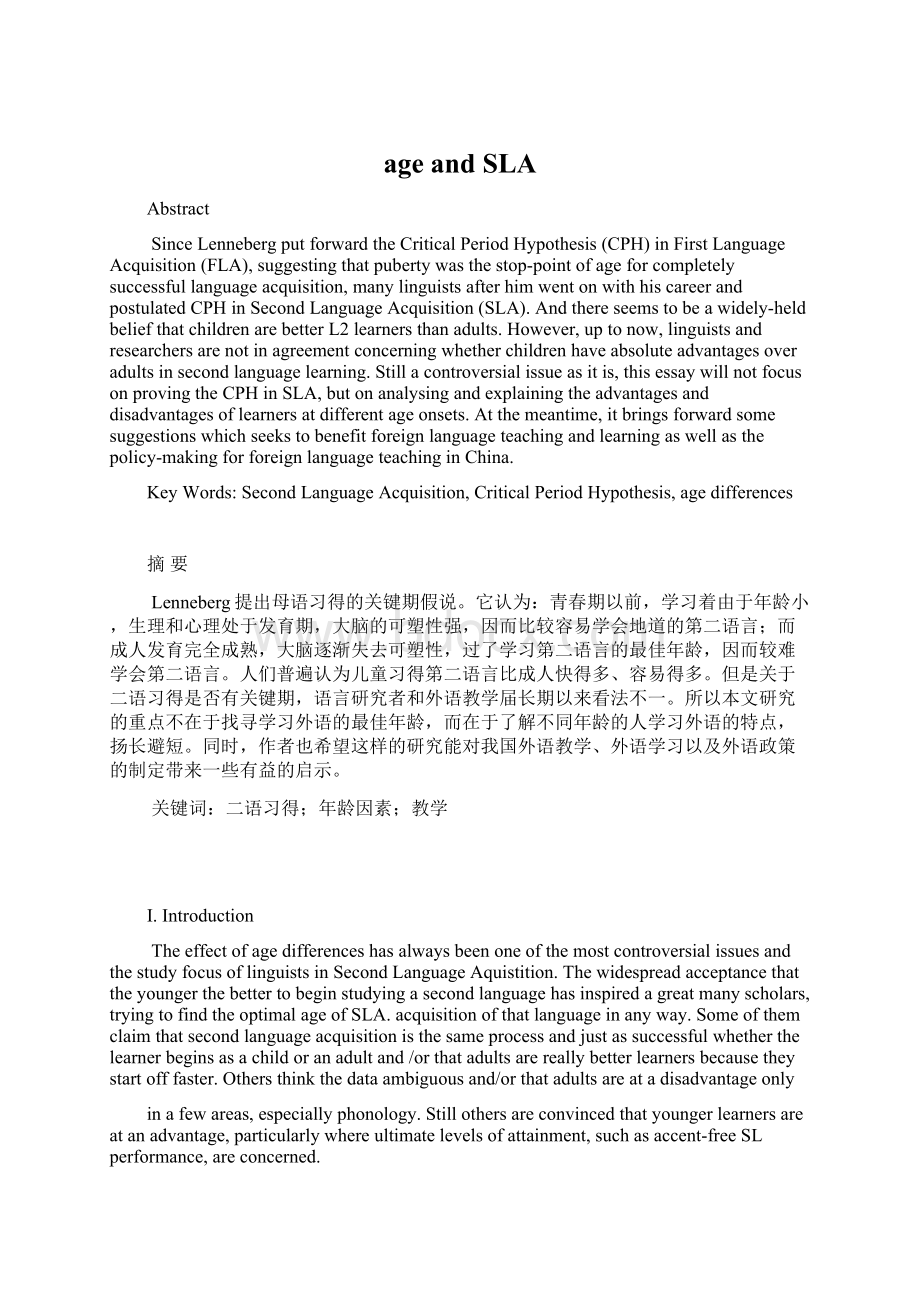age and SLA.docx
《age and SLA.docx》由会员分享,可在线阅读,更多相关《age and SLA.docx(10页珍藏版)》请在冰豆网上搜索。

ageandSLA
Abstract
SinceLennebergputforwardtheCriticalPeriodHypothesis(CPH)inFirstLanguageAcquisition(FLA),suggestingthatpubertywasthestop-pointofageforcompletelysuccessfullanguageacquisition,manylinguistsafterhimwentonwithhiscareerandpostulatedCPHinSecondLanguageAcquisition(SLA).Andthereseemstobeawidely-heldbeliefthatchildrenarebetterL2learnersthanadults.However,uptonow,linguistsandresearchersarenotinagreementconcerningwhetherchildrenhaveabsoluteadvantagesoveradultsinsecondlanguagelearning.Stillacontroversialissueasitis,thisessaywillnotfocusonprovingtheCPHinSLA,butonanalysingandexplainingtheadvantagesanddisadvantagesoflearnersatdifferentageonsets.Atthemeantime,itbringsforwardsomesuggestionswhichseekstobenefitforeignlanguageteachingandlearningaswellasthepolicy-makingforforeignlanguageteachinginChina.
KeyWords:
SecondLanguageAcquisition,CriticalPeriodHypothesis,agedifferences
摘要
Lenneberg提出母语习得的关键期假说。
它认为:
青春期以前,学习着由于年龄小,生理和心理处于发育期,大脑的可塑性强,因而比较容易学会地道的第二语言;而成人发育完全成熟,大脑逐渐失去可塑性,过了学习第二语言的最佳年龄,因而较难学会第二语言。
人们普遍认为儿童习得第二语言比成人快得多、容易得多。
但是关于二语习得是否有关键期,语言研究者和外语教学届长期以来看法不一。
所以本文研究的重点不在于找寻学习外语的最佳年龄,而在于了解不同年龄的人学习外语的特点,扬长避短。
同时,作者也希望这样的研究能对我国外语教学、外语学习以及外语政策的制定带来一些有益的启示。
关键词:
二语习得;年龄因素;教学
Ⅰ.Introduction
TheeffectofagedifferenceshasalwaysbeenoneofthemostcontroversialissuesandthestudyfocusoflinguistsinSecondLanguageAquistition.Thewidespreadacceptancethattheyoungerthebettertobeginstudyingasecondlanguagehasinspiredagreatmanyscholars,tryingtofindtheoptimalageofSLA.acquisitionofthatlanguageinanyway.Someofthemclaimthatsecondlanguageacquisitionisthesameprocessandjustassuccessfulwhetherthelearnerbeginsasachildoranadultand/orthatadultsarereallybetterlearnersbecausetheystartofffaster.Othersthinkthedataambiguousand/orthatadultsareatadisadvantageonly
inafewareas,especiallyphonology.Stillothersareconvincedthatyoungerlearnersareatanadvantage,particularlywhereultimatelevelsofattainment,suchasaccent-freeSLperformance,areconcerned.
Amongthetheoriesandhypothesis,averycontroversialoneaboutsecondlanguageacquisitionistheCriticalPeriodHypothesisbyLenneberg(1967),whostatesthatthereisaperiodwhenlanguageacquisitioncantakeplacenaturallyandeffortlessly,butafteracertainage,thebrainisnolongerabletoprocesslanguageinputinthisway.
InChinatoday,thereisacommonbeliefthatchildrenshouldstarttolearnaforeignlanguageasearlyaspossible.Asaresult,manyparentssendtheirchildrentolanguageschoolswiththehopethattheirchildrenwillbegoodEnglishlearners.Atthesametime,Englishtrainingcoursesforkidsmushroomalloverthecountry,andmanyEnglishtextbooksandtapesforkidsbecomebest-sellers.Allthisaddstotheconfusionoftherealmofeducationanddrawstheattentionofparentsandsociety.ThisessaywillnotfocusonprovingtheCPHinSLA,butonanalysingandexplainingtheadvantagesanddisadvantagesoflearnersatdifferentageonsets.Atthemeantime,itbringsforwardsomesuggestionswhichseekstobenefitforeignlanguageteachingandlearningaswellasthepolicy-makingforforeignlanguageteachinginChina.
Ⅱ.TheEffectsofAgeonSecondLanguageAcquisition
A.TheEffectsofAgeonRateofSecondLanguageLearning
Krashen,Long,andScarcella(1979)drewaconclusionconcerningtheeffectsofageonrageofSLA:
(1)adultsaresuperiortochildreninrateofacquisition,and
(2)olderchildrenlearnmorerapidlythanyoungerchildren(Krashen,etal,1979).ThisissupportedbySnowandHoefnagel-hohle(1978)’sresearch.TheystudiedDutchlearningof51AmericansinHollandin1978.Thesubjectsweredividedintofiveagegroups:
ten3-to-5-year-olds,eight6-to-7-year-olds,thirteen8-to-10-year-olds,nine12-to-15-year-olds,andelevenadults.Theresultsofthestudyimpliedthat3一to-5-year-oldsscoredlowerthantheoldergroupsonallthetestsandthe12-to-15-year-oldsshowedthemostrapidacquisitionofalltheskillstested.AnnFathmanalsomadeastudyin1982toexaminetherelationshipbetweencertainaspectsofthesecondlanguageacquisitionprocessandagethroughanoralproductiontest.Thesubjectswere200children(aged6to15)fromdiverselanguagebackgroundswhowerelearningEnglishasasecondlanguageinpublicschools.TheresultsindicatedthattheolderchildrenperformedbetterintheproductionofcorrectmorphologicalandsyntacticstructureswhereastheyoungerchildrenweresuperiorintheuseofcorrectEnglishpronunciation.Therearesomeothershort-termstudiesbyfamousscholarsthatcomparesecondlanguagelearnersatdifferentage-onsets,theresultsofwhichareinconsistencewiththehypothesisthatadolescentsandadultshavemanyadvantagesinsecondlanguageacquisition,suchasfasterspeedinlanguageacquisitionandstrongabilitytoacquiresyntaxandmorphologywhilechildrenperformmuchbetterinphonology.
B.TheEffectsofAgeontheAcquisitionofNative-LikeProficiency
Astotheeffectsofageontheacquisitionofnative-likeproficiency,somescholarscarriedoutempiricalstudiesandamajorityofthemholdtheassumptionthattheaccentofthosewhoarriveatanearlyageismorelikelytoapproachanative-likelevelthanisthatofolderarrivals.
Inastudyof71CubanimmigrantstotheUnitedStates,aged7-19,Asher&Garcia(1969),foundthatmembersofagroupwhohadarrivedbetweenageoneandsixandhadlivedintheUnitedStatesforfivetoeightyearsweremostlikelytoberatedatthe"near-nativespeaker"level,thusingeneralupholdingtheprinciplethattheyoungerthechildonarrival,thehighertheprobabilityofapproachinganativeaccent.OyamafoundalinearrelationshipbetweenageofarrivalandtheabilitytomasterthephonologicalsystemofEnglishby60maleItalianimmigrantswhohadbeenintheUnitedStatesforatleastfiveyears.Inherstudy,subjectswererequiredtoreadapassagealoudandtotellananecdotefrompersonalexperience;therecordingswerethenratedbytwojudgesfordegreesofnon-nativeaccent.Oyamasummarizesherfindingsasfollows:
"Theyoungestarrivalsperformintherangesetbythecontrols,whereasthosearrivingafteraboutage12donot,andsubstantialaccentsstartappearingmuchearlier"(Oyama,1976:
272).
However,counterevidencesarefoundbyotherstudies,theresultsofwhichfavorolderlearnersinacquiringnative-likeproficiency.TakeNeufeld’s(1978)studyasanexample.Inthisstudy,20adultnativespeakersofEnglishweregiven18hoursofintensiveinstructioninthepronunciationofChineseandJapanese.Totestthe"nativeness"oftheirpronunciation,thelearnerswerethengivenanimitationtestandtheirutterancesjudgedonafive-pointscalefrom`unmistakablynative'to`heavilyaccented',bynativespeakersofthetwolanguages.Nineandeightofthesubjectswereratedas`native'forJapaneseandChineserespectively.Thisstudysuggeststhatundertherightconditionsadultscanachievenativeabilityinpronunciation.
Thecontradictoryresultsaboveprovethatthisissueisstillarathercontroversialoneandtheverdictremainsopen.
C.TheEffectsofAgeonLearners'SecondLanguageAchievement
Theshort-termstudieswhichcompareolderandyoungerchildrenconsistentlyshowthatolderchildrenarefasterlearnersofsyntaxandmorphologywhenthedurationoftheexposuretothesecondlanguageissimilar.Thencomesthequestion:
Dolearnerswhobeginlearningaschildreningeneralreachhigherlevelsofsecondlanguageabilitythanthosewhostartasadolescentsoradults?
Toanswerthisquestion,somescholarshavedoneaseriesofresearchesandexperiments.
Burstalletal.(1974),forexample,found,intheircomparisonofBritishchildrenwhostartedlearningFrenchinschoolateitherage8or11,thatbythetimebothgroupsreachedage16,therewasonlyonetestresultinfavouroftheearlylearners:
namely,alightlybetterperformanceinlisteningcomprehension.Theeight-year-oldbeginnerswerenolongeraheadinoralproductionastheyhadbeenwhencomparedafterthreeyearsofexposurewithanoldergroup.
Harley(1986)investigatedthelevelsofattainmentofchildreninFrenchbilingualprogrammesinCanada.Shefocusedonthelearners'acquisitionoftheFrenchverbsystem,obtainingdatafrominterviews,astoryrepetitiontask,andatranslationtask.Shecomparedearlyandlateimmersionstudentsafterbothhadreceived1,000hoursofinstruction.Neithergrouphadacquiredfullcontroloftheverbsystem,buttheolderstudentsdemonstratedgreateroverallcontrol.
Afterwehavereviewedtheabovestudiesdonebypreviousresearches,itcanbefoundoutthat,olderlearnershaveadvantagesinsecondlanguageachievement.
Ⅲ.ExplanationsfortheeffectsofageonSLA
ThedifferencesinthethreeagegroupsofL2learnersarousedalotofresearchers'interestsinsearchingforthecreditableexplanationforthephenomena.Atleastfourmaintypesofexplanationshavebeenofferedforagedifferences,whichincludeneurologicalconsiderations,cognitivedifference,affectivedifferenceandlinguisticdifference.
A.Neurologicaldifference
Neurologicaldifference,thatis,lateralizationcompletedattheageofpuberty,maywellexplaintheobserveddifferencesinlanguageproficiencyobtainedbylearnersatdifferentonsetage.Awell-knownhypothesisisthatthereareclearneurologicaldifferencesbetweenchildandadultbrains,andthatthesedifferencesaredirectlyresponsibleforchild-adultdifferencesinlanguageacqu